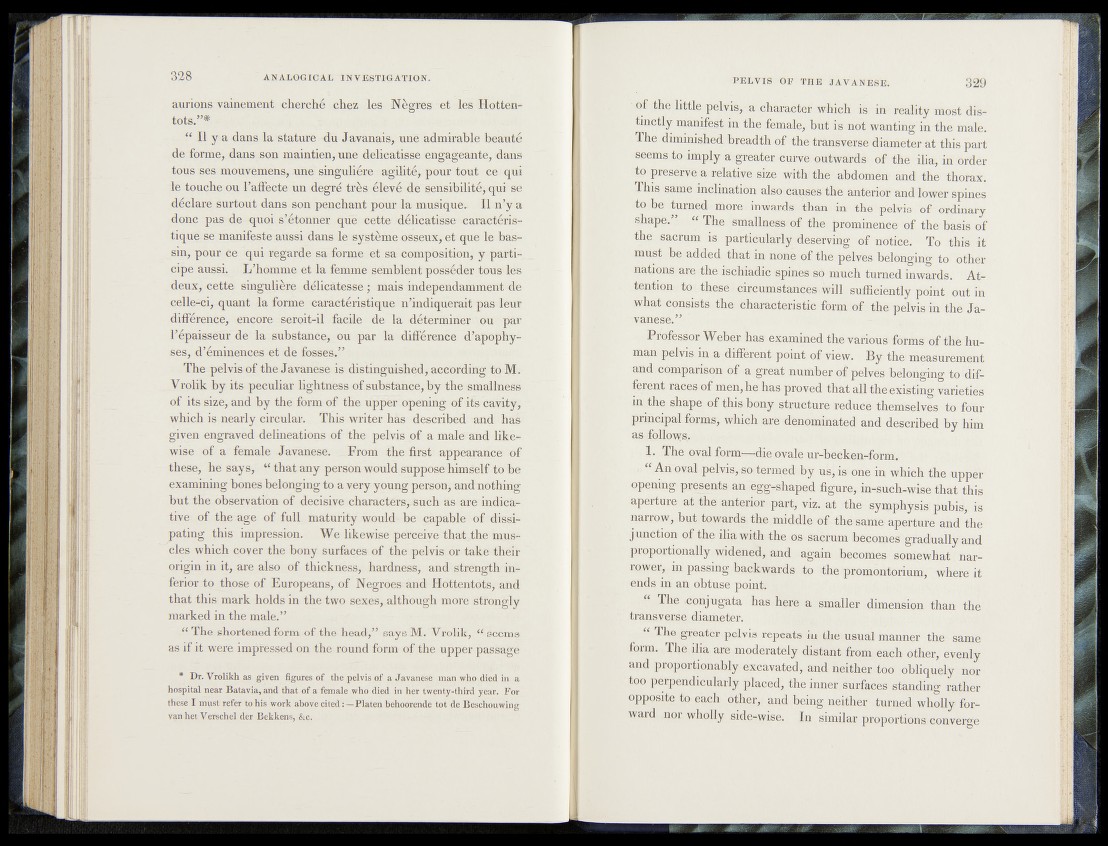
aurions vainement cherché chez les Nègres "étalés Hottentots.”*
-
“ Il y a dans la stature «du Javanais, une admirable beauté
de forme, dans son maintien, une delicatisse .engageante, dans
tous ses. mouveméns, .une" singulière agilité, pour tout © ë f qui
le touche ou l’affecte un degré très élevé de sensibilité, qui se;
déclare surtout dans son penchant pour la musiques II n ’y a
donc pas de quoi s’étonner que cette déhcatisse--caractéristique
se manifeste aussi dans le système osseux, et que le bassin,
pour ce qui regarde sa forme et sa composition, y participe
aussi. L ’homme et la femme sémblent posséder tous^lès
deux, cette singulière délicàtesse ; mais indépendamment de
celle-ci, quant la forme caractéristique n’indiquerait pas leur
différence, encore seroit-il facile de la déterminer ou par
l’épaisseur de la substance, ou par la différence d’apophyses,
d’éminences et de fiasses.’’ -
The pelvis of the Javanese is distinguished * according tq M.
_Vrolik by its peculiar lightness of substance, by the smallftèSS
of its size, and by the form of the upper-opening ofiipçavity,
which is nearly circulai-. This writer hàs' described and has
given engraved delineations of the pelvis of a male and likewise
of a female Javanese. From the first appearance of
these, he says,r “ that any person would suppose himself to be
examining bones belonging to a very young person, and nothing
but the observation of decisive charactersr suchi ate are indicative
of the age of full maturity would-be capable of dissipating
this impression. We likewise perceive th a t,the muscles
which coyer the bony surfaces of the pelvis or take their
origin in it, are also of thickness, hardness, and strength inferior
to those of Europeans, of Negroes and Hottentots, and
that this mark holds in the two sexes, although more strongly
marked in the.male,”
The shortened form of the head,” says M. Vrolik, “ seems
as if it were impressed on the round form of the upper passage
* Dr. Vrolikh as given figures of the pelvis of a Javanese man who died in. a
hospital near Batavia, and that of a female who died in her twenty-third year. For
these I mast refer to his work above cited Platen behoorende tot de Beschouwing
van het Verschel der Bekkens, &c.
329
of the; little pelvis,.a character which is in reality most distinctly
manifest in? the\female, but is not wanting in the male.
The diminished breadth of the transverse diameter at this part
•spems tO’injf^y ^g reater c u ^ o u ttv aM s -o f the ilia, inhrder
* prese®ve,>aArelative-;size with* the" abdomerl' and’ the thofax.
Tbi§ ‘S^me inclination also^eau^e^' th'e anterior and lower spines
?%>fee - turned more - inwards^#han’;im|the pelvis of ordinary
shape.” “ The smallnesssof the prominericerof the- basis of
the sacrum dsL-particularly?-’dSsCrvi4g of notice.' To this it
must be added thapin none of;.the pelves.belonging to other
nations are the ischiadic spines1 gg much turned inwards. Attention,,
to- these«circumstances.will sufficient^;pdiht)«out in
w h a^cp n ^& .th e characteristic form/ofi-the pelvis in the Ja-
-vanese.^ll^
^^^%kso4WeSfehas examined the various- forms of the human
pelvis in a-different point of view. By the4 hhfksurement
and comparison o f a. great number of pelves bhlhkgipg to different
races:of,men, be has proved that all the existing varieties
in the shape d this bony structure deduce themselves- to four
principal forms, which are denominated and described by him
as follows,.
1. The oval form—die,ovale ur-becken-form.
* “ pelvis,«ee;termed- by us, is^one in which the upper
opening presents an egg-shaped,figure, in-such-wise that this
aperture at the anterior part, viz. at the > Syipphysis pubis', is
yarrow, but towards the middle of-the^arne aperture arid the^'
junction of the ilia with the os sacrum becomes gradually and
proportionally widened, and again becomes somewhat narrower,
in passing backwards to the promontorium, where it
ends in an obtuse point.
The .conjugata has here a smaller dimension than the
transverse diameter.
The greater pelvis repeats in the usual manner the same
form. The ilia are moderately distant from each other, etenly
and proportionally excavated, and neither too obliquely nor
too perpendicularly placed, the inner surfaces standing rather
opposite to each other, and being neither turned wholly forward
mor wholly side-wise. In similar proportions converge
I . 4Mt É# isste